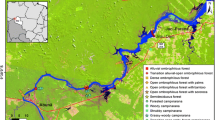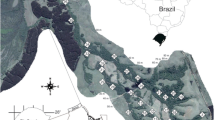Abstract
This study investigates the riverine vegetation along the perennial Omo River, which flows from the Ethiopian highlands to its terminus, in the southwestern lowlands, at Lake Turkana (formerly Lake Rudolf). Broadly defined to include the levee backslopes and adjacent mudflats (or ancient floodplains), the riverine zone in the lower Omo basin supports a relatively luxuriant vegetation compared with the dry grasslands in the surrounding plains environments. Habitat conditions along the lower Omo have changed significantly during the past century, primarily due to a period of reduced rainfall and river flow, a drop in lake level (L. Turkana) at the river's terminus and increased exposure of natural levees near the Omo's terminus. The floristic and physiognomic character of riverine vegetation were studied at selected sites, ranging from the relatively straight channel section in the modern delta to a strongly meandering (upstream) section of the river. A combination of open canopy woodland, shrub thicket and grassland (with scattered tree emergents) prevailed on the more recently exposed levees, in and near the modern delta; closed canopy woodland and forest predominated on fore levees in the meandering segment. Floristic diversity was relatively low at all study sites. Ficus sycomorus, Tapura fischeri, Melanodiscus oblongus, Celtis integrifolia and Trichilia roka were most significant in upstream forest sites, whereas Cordia sinensis, Acacia mellifera, Ziziphus mauritiana and Ficus sycomorus were more common in communities nearer the lake. Older forests generally contained greater diversity of more woody species, greater tree height and truck diameter than downstream levee vegetation, but they did not exhibit clear stratification. Species patchiness was broadly characteristic of the riverine zone, particularly the mudflats (ancient floodplains) extending away from the fore levees. Fires are frequently set by local inhabitants throughout the grasslands of the lower Omo Basin; within the riverine zone, they are particularly common in the mudflats but have only limited impact on woodland and forest vegetation. It is suggested that fire is a highly significant factor in the establishment of sharp boundaries between the closed canopy woodland/forest along the river and the more xerophytic vegetation of the mudflats.
Similar content being viewed by others
References
Andrews, P., Groves, C. P. & Home, J. F. M. 1975. Ecology of the lower Tana River floodplain, Kenya. J. East African Nat. History Soc. Nat. Museums 151: 1-31.
Barkham, J. P. & Rainy, M. E. 1976. The vegetation of the Samburu-Isiolo Game Reserve. East Afr. Wildlife J. 14: 297-329.
Boaz, D. D. 1982. Modern Riverine Taphonomy: Its Relevance to the Interpretation of PlioPleistocene Hominid Paleoecology in the Omo Basin. Ethiopia. Ph.D. Dissertation, University of California, Berkeley.
Butzer, K.W. 1971. Recent history of an Ethiopian delta. University of Chicago, Department of Geography, Research Paper 136. University of Chicago, 184 pp.
Carr, C. J. 1976. Plant ecological pattern and paleoecology in the lower Omo Basin. In: Coppens, Y., Howell, F. C., Isaac, F. L. & Leakey R. E. F. (eds) Earliest man and environment in the Lake Rudolf Basin, 3 Vols. University of Chicago Press, Chicago, 615 pp. Carr, C. J. 1977. Pastoralism in crisis: The Dasanetch of Ethiopia and their lands. University of Chicago, Department of Geography, Research Paper 180, University of Chicago, 365 pp.
Charugi, A. 1953. Adumbratio florae Aethiopicae. Webbia 9, 1-8.
Chiovenda, E. 1951. Missione Biological Sagan-Omo. Webbia 8: 1-24.
Cottam, G. & Curtis, J. T. 1956. The use of distance measures in phytosociological sampling. Ecology 37: 451-60.
Cufodontis, G. 1939. Familae complures. Missione Biological nel Paese dei Borana. Reale Accademia d'Italia, Centro Studi per l'A.O.I. 4 (IV), Rome.
Cufodontis, G. 1948, Die compositen der Italienischen Biologischen Expedition zum Sagan-und Omo-Fluss in SW. Aethiopien Ann. Naturhistorischen Museums Wien 56: 150-187.
cufodontis, G. 1953. Enumeratio plantarum Aethiopiae Spermatophyta. Nationale Plantentuin Van Belgie 33(Supplement): 1-16.
Dansereau, P. 1958. A universal system for recording vegetation. Contributions de l'Institut Botanique de l'Universite de Montreal, p. 72.
D'Ossat, G. A. & Millosevich, F. 1900. Studio geologico sul materiale raccolto da M. Sacchi. Societa Geografica Italiana, Roma, 212 pp.
Edwards, D. 1967. A plant ecological survey of the Tugela River Basin. Mem. Bot. Survey South Africa 36: 1-286.
Farrell, J. A. K. 1968. Preliminary notes on the vegetation of the lower Sabi-Lundi Basin, Rhodesia. Kirkia 6: 223-248.
Friis, I., Rasmussen, F. N. & Vollesen, K. 1982. Studies in the flora and vegetation of southwest Ethiopia. Opera Bot. 63: 1-70.
Friis, I. & Vollesen, K. 1989. Notes on the vegetation of southernmost Somalia, with some additions to the flora. Willdenowia 18: 455-475.
Furness, H. D. & Breen, H. C. 1980. The vegetation of seasonally flooded areas of the Pongolo River floodplain. Bothalia 13(1 & 2): 217-230.
Gillett, J. B. 1955. The relation between the highland floras of Ethiopia and British East Africa. Webbia 9: 459-66.
Goode, R. 1964. The geography of the flowering plants. Longmans, London. 518 pp.
Greenway, P. J. 1973. A classification of the vegetation of East Africa. Kirkia 9: 1-68.
Guy, P. R. 1981a. Changes in the biomass and productivity of woodlands in the Sengwa Wildlife Research Area, Zimbabwe. J. Appl. Ecol. 18: 507-519.
Guy, P. R. 1981b. Changes in the herb layer of the riverine woodland in the Sengwa Wildlife Research Area, Zimbabwe. Bothalia 13(3, 4): 527-530.
Gwynne, M. D. 1969. The South Turkana expedition scientific papers 1. Preliminary report on the 1968 season. Geogr. J. 135: 331-42.
Halwagy, R. 1963. Studies on the succession of vegetation on some islands and sandbanks in the Nile near Khartoum, Sudan. Vegetatio 11: 217-234.
Hedberg, O. 1962. Mountain plants from southern Ethiopia, collected by Dr John Eriksson. Arkiv Botanik 4: 421-35.
Hughes, F. M. R. 1988. The ecology of African floodplain forests in semi-arid and arid zones: a review. J. Biog. 15: 127-140.
Hughes, F. M. R. 1990. The influence of flooding regimes on forest distribution and composition along the Tana River, kenya. J. Appl. Ecol. 27: 473-491.
Keay, R. W. J. 1959. Vegetation map of Africa South of the Tropic of Cancer. UNESCO, London.
Kershaw, K. A. 1963. Pattern in vegetation and its causality. Ecology 44: 377-88.
Lanza, D. 1939. Familae complures in Missione Biologica nel paese dei Borana. Reale Accademia d'Italia, Centro Studi per l'A.O.I. 4 (IV), Roma.
Madwick, J. 1986. Ecology of riverine forest in the Jubba Valley. In: J. Madwick, B. Wood, N. Varty & M. Maunder (eds) 1986 Somalia research project (Final Report). University College, London.
Medley, K. E. 1992. Patterns of forest diversity along the Tana River, Kenya. J. Tropical Ecol. 8: 353-371.
Morgan, W. T. W. 1971. The South Turkana expedition scientific papers IV. Land units of the Lorori area. Geogr. J. 137: 14-28.
Pichi-Sermolli, R. E. G. 1950. Sulla sistematica e nomenclatura di alcune plante dell'Abissinia. Webbia 7: 325-351.
Pichi-Sermolli, R. E. G. 1954. Adumbratio Florae Aethiopicae. Webbia 9(2): 623-660.
Pichi-Sermolli, R. E. G. 1957. Una carta geobotanica dell'Africa Orientale (Eritrea, Ethiopia, Somalia). Webbia 13: 15-132.
Schweinfurth, G. 1892. Aufzahlung der von Hoehnel gasammelten Pflanzen. 23 pp. In: L. von Hoehnel. Zum Rudolph-See und Stephanie-See (ex Aethiopia 6 species tantum).
Simpson, C. D. 1975. A detailed vegetation study on the Chobe River in northeast botswana. Kirkia 10: 185-217.
Sorensen, T. 1948. A method of establishing groups of equal amplitude in plant sociology based on similarity of species content. Kongelige Danske Videnskabernes Selskab Biologiske Skrifter 4: 1-34.
Ward, J. D. & Breen, C. M. 1983. Drought stress and the demise of Acacia albida along the lower Kuiseb River, Central Namib Desert: preliminary findings. South African J. Sci. 79: 444-447.
Vannutelli, L. & Citerni, C. 1887. Relazione preliminare sui risulati geografici della deconda spedizione Bottego. Soc. Geog. Italiana, Series 3, 10: 320-330.
Von Hohnel, L. 1938. The Lake Rudolf region: its discovery and subsequent exploration, 1888-1909. J. Roy. African society London 37: 16-45, 206-26.
Author information
Authors and Affiliations
Rights and permissions
About this article
Cite this article
Carr, C.J. Patterns of vegetation along the Omo River in southwest Ethiopia. Plant Ecology 135, 135–163 (1998). https://doi.org/10.1023/A:1009704427916
Issue Date:
DOI: https://doi.org/10.1023/A:1009704427916




